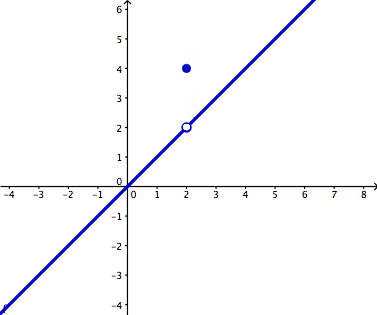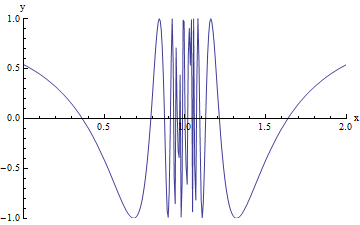Continuity is when the graph is predictable, has no breaks, jumps, or holes, could be drawn without lifting the pencil, and has the same value as the limit.
Discontinuity is the opposite: it is unpredictable, does have breaks, jumps, and holes, cannot be drawn without lifting the pencil, and varies if the value and the limit are the same. There are two families of discontinuities: removable and non-removable. A point discontinuity is the removable discontinuity, which is also known has the hole. There are three types of non-removable discontinuities: jump, which shows a "jump" or space between the function, infinite, which is also known as unbounded behavior and occurs where there is a vertical asymptote, and oscillating behavior, which shows the function as a condensed set of "wiggles".
 |
| Point discontinuity http://dj1hlxw0wr920.cloudfront.net/userfiles/wyzfiles/4a69dec7-03e0-492f-ac16-4dcd555579c9.gif |
 |
| Jump Discontinuity http://image.tutorvista.com/content/feed/u364/discontin.GIF |
 |
| Infinite Discontinuity http://image.tutorvista.com/cms/images/67/inv-function-eg.JPG Oscillating behavior http://www.cwladis.com/math301/lecture%20images/infiniteoscillationdiscontinuityat1.gif |
A limit is the intended height of a function and is read as "the limit as x approaches 'a number' of f(x) is equal to 'L' ". A limit exists as long as you reach the same height from both the left and the right direction. If the graph does not break at a given x-value, then the limit will exist there. This means that a limit will exists in functions with holes. However, a limit will not be reached in non-removable discontinuities such as jumps, infinite discontinuities, or oscillating behavior. For jumps, the limit does not exist because the function has different left/right heights. For infinite discontinuities, the limit does not exist because of unbounded because due to vertical asymptotes. However, we can still write one-sided limits. While limit is the intended height, the value is the actual height. This means that the limit and value can be the same or different depending on the function. Sometimes, there may be no actual value, as in the case with 2 open circles.
http://00.educdn.com/files/static/mcgrawhillprof/9780071624756/LIMITS_AND_CONTINUITY_RAPID_REVIEW_02.GIF
As you can see here, the open circle (which is the limit) is different from the closed circle (which is the value).
3. How do we evaluate limits numerically, graphically, and algebraically?
To evaluate limits numerically, you will have to begin by drawing a table with 3 left and 3 right of number x is approaching. The values on the ends should be a tenth away from the center, and the closer you get to the center, the closer you get to the x-value. You would then plug the function into your graphing calculator and could either trace the location of the x-value or solve the function. An example can be seen below.
http://people.hofstra.edu/stefan_waner/realworld/tutorials/frames2_6a.html
To evaluate limits graphically, "plug the function into the y= screen on your graphing calculator. Then you can either go to 'tblset', make your independent variable 'ask', go to table, and then type in the values close to the limit. Or you could go to 'graph, hit 'trace', and trace to the value you are looking for" (Kirch). To find the limit, put your finger on a spot to the left and to the right of where you want to evaluate the limit and then move them together to find where they meet. If they don't, then there is no limit.
https://www.youtube.com/watch?v=_IT4hSM9DjA
When solving for limits algebraically, you need to begin with the direct substitution method. Like the name, all you need to do is take the number the limit is approaching and plug it in anywhere you see x. Through substitution, we can get 4 types of answers:
1. numerical answer
2. 0/#, which is 0
3. #/0 which is undefined and the limit does not exist
4. 0/0 indeterminate form
https://www.youtube.com/watch?v=1AKrjrl6Xpw
Now, if we end up with an indeterminate form, we must use another method to solve for the limit. The first one we could try out is the dividing out/ factoring method. You factor both the numerator and denominator and cancel out the common terms to remove the 0 in the denominator. Then once again, you use substitution with the simplified expression.
https://www.youtube.com/watch?v=zpcBkRpqHqQ
Now if you are unable to factor out, you will have to use the rationalizing/conjugate method. First you multiply the top and bottom by the conjugate (whichever term has the RADICAL). Then you simplify by foiling the value that was used to find the conjugate but leaving the other FACTORED. Then cancel out common terms, and substitute the simplified function to find the limit.
https://www.youtube.com/watch?v=WVj284EvgBI


No comments:
Post a Comment